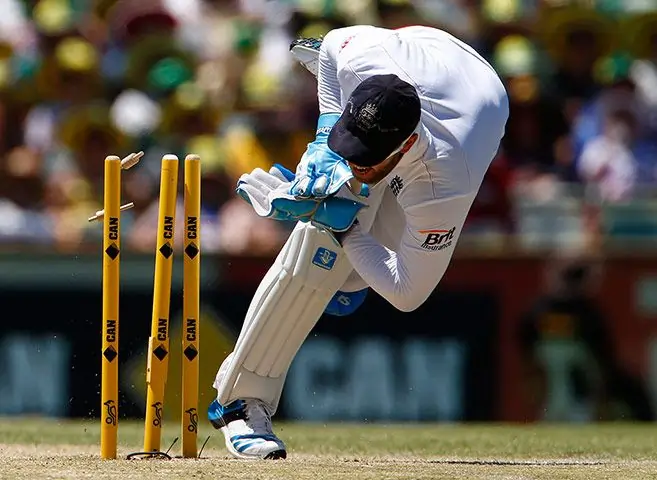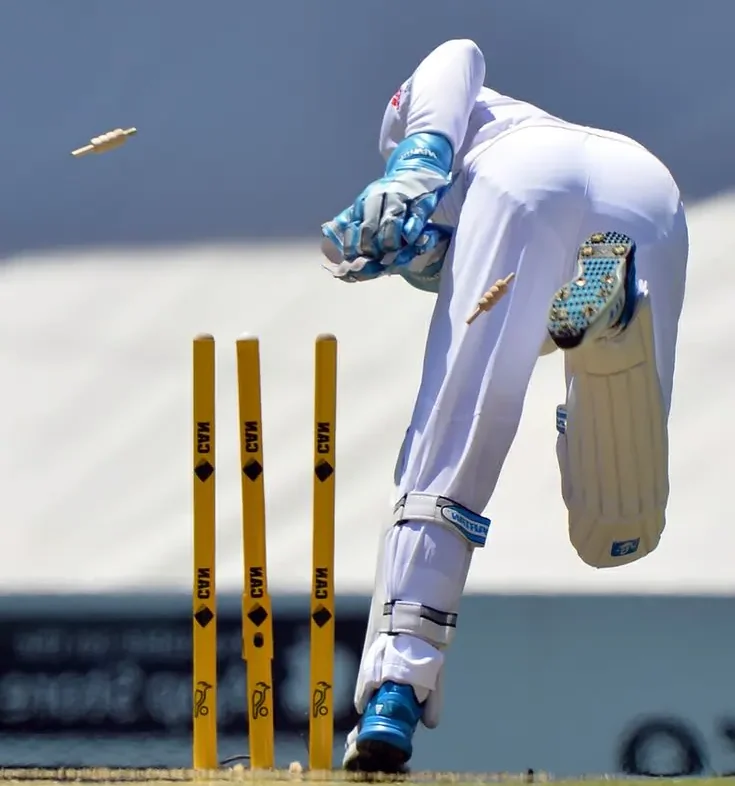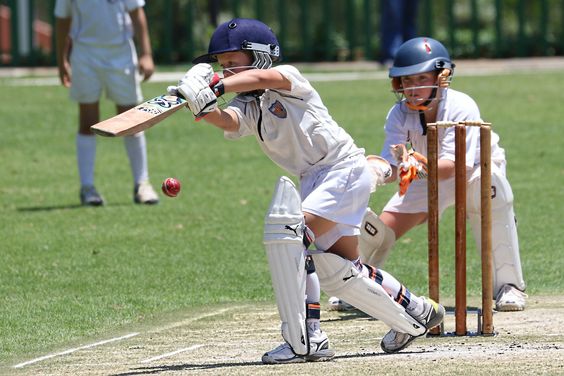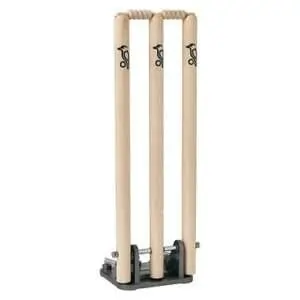Rules for Stumping in Cricket
Cricket has a cool way to get a batter out called “stumping.” Imagine the batter is out of his little safe zone (called a crease) and forgets to guard the wickets (those three wooden posts). If the wicket-keeper (the guy behind the wickets) is super fast and snatches the bails (two sticks on top) of the wickets before the batter gets back, the batter is OUT! It’s like a game of tag, but way more exciting!
Also, read about the supremacy behind wickets Exploring the Area Behind the Stumps in Cricket
Understanding the Basics
Before we dive into the finer details, let’s establish a solid foundation by exploring the fundamental concepts of stumping in cricket.
What Is Stumping?
Stumping is a method of dismissing a batsman in cricket. It occurs when the wicketkeeper removes the bails from the stumps while the batsman is out of the crease and not attempting a shot. The key here is that the batsman must have both feet grounded outside the crease for a stumping to be valid.
The Role of the Wicketkeeper
The wicketkeeper in cricket plays a pivotal role in both the batting and fielding aspects of the game. Primarily, their primary responsibility is to stand behind the stumps and ensure the safekeeping of the wickets. They are the last line of defense to prevent the opposition from scoring runs by stumping the batsmen or effecting run-outs. The wicketkeeper also needs to have quick reflexes and excellent hand-eye coordination to stop deliveries from the bowler and collect throws from the fielders accurately.
Rules Governing Stumping
Stumping in cricket is governed by specific rules to determine whether a batsman is out or not. To successfully stump a batsman, the wicketkeeper must remove the bails from the stumps while the batsman is outside the crease and not attempting a shot. For a stumping to be valid, the batsman must have both feet completely outside the crease. The wicketkeeper must do this swiftly and cleanly, without any part of their body or the ball touching the boundary or the stumps.
If the batsman is attempting a shot, even if they are out of the crease, they cannot be stumped. Stumping requires precise timing and skill, making it an exciting and challenging aspect of cricket for both wicketkeepers and bowlers.

Valid Delivery
For a stumping to be considered legal, the bowler must have delivered a legitimate ball. This means no no-balls or wides.
Batsman’s Disposition
The batsman must be in a position where they are not attempting a shot when the bails are dislodged. This often occurs when a batsman loses balance or steps out of the crease.
The Role of the Third Umpire
In modern cricket, the third umpire plays a crucial role in adjudicating stumpings. They use various camera angles and replays to ensure the correct decision is made.

Techniques for Successful Stumpings
Successful stumpings in cricket require a combination of technical proficiency and quick decision-making. The wicketkeeper should maintain a crouched position with their eyes focused on the bowler’s hand to anticipate the delivery. As the ball approaches, the keeper must stay balanced and ready to move quickly. When the batsman misses the ball or steps out of the crease, the wicketkeeper should swiftly gather the ball and dislodge the bails with a quick hand movement. Timing is crucial, as any delay can result in the batsman regaining their ground.
The keeper should also avoid overbalancing or touching the boundary with any part of their body or the ball while attempting the stumping. Effective communication with the bowler is essential to coordinate their actions. Successful stumpings demand precision, agility, and the ability to seize opportunities as they arise.
Quick Hands
Wicketkeepers must have lightning-fast reflexes. They practice catching the ball and removing the bails in one fluid motion.
Reading the Batsman
Experienced wicketkeepers pay close attention to the batsman’s movements. They anticipate when the batsman might lose balance or step out of the crease.
Communication with Fielders
Wicketkeepers often communicate with fielders to set traps for the batsman. This strategic approach can lead to successful stumpings.

Common Mistakes to Avoid
Avoiding common mistakes is essential for successful stumpings in cricket. One frequent error is being too hasty; the wicketkeeper should stay patient and wait for the right moment when the batsman is out of the crease. Overbalancing is another mistake to steer clear of, as any part of the body or the ball touching the boundary results in a boundary, not a stumping. Lack of communication with the bowler can lead to missed opportunities, so keeping the bowler informed about the batsman’s movements is crucial.
Lastly, failing to maintain proper hand-eye coordination and quick reflexes can result in missed chances. Stumpings require a combination of skill and precision, and avoiding these common errors can significantly increase the likelihood of a successful dismissal.
Preemptive Movements
Wicketkeepers must refrain from moving too early. Premature movements can alert the batsman and result in missed opportunities.
Slow Reactions
Sluggish reactions can cost a wicket. Wicketkeepers must stay alert and be ready to pounce at a moment’s notice.
Conclusion
In conclusion, mastering the art of stumping in cricket requires a blend of skill, intuition, and practice. Wicketkeepers play a pivotal role in changing the course of a game through well-executed stumpings. By understanding the rules and honing their techniques, they become formidable assets to their teams.
FAQs
Is a stumping possible if the batsman’s foot is on the crease line?
No, for a stumping to be valid, both feet of the batsman must be completely outside the crease.
Are there any specific conditions under which the third umpire can intervene in stumpings?
Yes, the third umpire can intervene if there is any doubt regarding the validity of a stumping, especially when the batsman is on the crease line.
What happens if a wicketkeeper accidentally dislodges the bails before the bowler delivers the ball?
If the bails are dislodged accidentally before the bowler delivers the ball, it is not considered a stumping, and the batsman continues.
Can stumpings be performed off a no-ball delivery?
No, stumpings can only occur off a legitimate delivery. If the bowler delivers a no-ball, a stumping cannot be attempted.
Is there any age limit for becoming a wicketkeeper in professional cricket?
There is no specific age limit, but wicketkeepers typically start their training at a young age to develop the required skills.










